Boat watching in Duluth
In this Lake Superior port town, tourists hang on the latest shipping news.
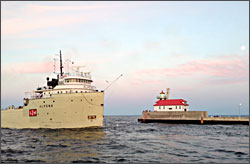
© Beth Gauper
When the ore boats start arriving in Duluth, the tourists soon follow.
Fifty years ago, ships were part of the industrial landscape on Canal Park, and no one thought they were all that romantic.
But things have changed. Today, these hulking big boats are to Duluth what killer whales are to Sea World. Because, boy, do they make people come running.
The first time I went boat-watching in Duluth, I hit the jackpot. As I drove up to Canal Park at 4:40 p.m. one day in June, the bells began to ring, and the Aerial Lift Bridge began to rise.
A few minutes later, the Adam Cornelius from Ohio pushed through the canal, making its dark waters heave like a fat man on a waterbed.
At the dot of 5, the rust-colored hull of the Kinsman Enterprise approached, and at 5:30, the saltie Federal Vibeke out of Oslo, Norway, departed, followed closely by a dozen yachts and sailboats.
After that, I was hooked.
Duluth doesn't have the levels of boat traffic it once had, though it's by far the largest port on the Great Lakes. But the boats that do come are much bigger, and watching them is addictive.
Watching giant lakers
I'm standing next to the Marine Museum on a warm day in late August as the bell on the 1930 Aerial Lift Bridge starts to clang, raising an expectant tingle along my spine.
From the parking lots of Canal Park hotels, people start running toward the canal as the bridge's steel deck rises. Cars zoom up and families jump out.
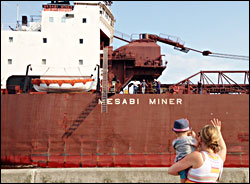
© Beth Gauper
The 1,000-foot Water J. McCarthy is approaching, on its way to pick up 600 rail cars of coal from Montana. Raptly, we all watch as its broad bow eases into the narrow canal and looms above us. Scanning the decks, I return waves from the crew, only a few yards away.
"Geez, that baby is huge," mutters a man next to me, as it passes.
A cluster of German tourists are talking among themselves; listening hard, I hear mostly numbers — siebenhundertsiebzehn, dreihundertvierzehn — big numbers that describe the girth of this workhorse, one of 13 thousand-footers on the Great Lakes.
As it slides into the harbor, the captain leans on the horn for a series of throaty bellows that, guides explain grandly, is the traditional salute to the bridge tender — though, when pressed, they admit it's really for the tourists.
They are legion; the logbook in the Marine Museum is filled with names of the regulars, people who view the boats' comings and goings with the attentiveness usually reserved for the running of the horses, except these are called Cornelius and Barker and Tregurtha.
I never tire of watching these boats arrive, whether they're the sleek corporate lakers or scruffier salties like the Antalina and Lok Prakash, ships from Cyprus and India that usually anchor out in the lake, saving docking fees while they wait their turns to load up on grain.
For catching a whiff of far-off places, Duluth beats that hands down. It sits at the end of the 2,342-mile passage from the Atlantic Ocean, sailed by ships from the Netherlands and Italy and Malta on their way to fetch the grains of the Midwest, or to bring massive turbine parts to its wind farms.
The ships pass Montreal, and Niagara Falls, and the Soo Locks — and finally they see this little city sprawling down a hillside, at the tip of the farthest finger of Lake Superior.
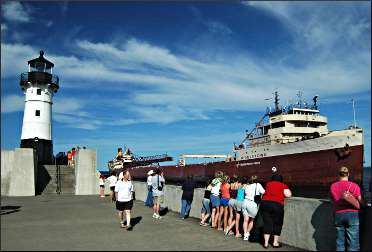
© Torsten Muller
Romance . . . and danger
Even here, sailors were not safe from the lake with the hair-trigger temper. One of the most famous Lake Superior wrecks was the Mataafa, pushed against Duluth's pier by a giant wave in November 1905.
Life on the lake was rough. In Duluth's Maritime Visitors Center, there's a re-created cabin from an 1870s schooner in which a papier-mache sailor complains of "a regular dog's life."
It's not a cakewalk even today; also in the museum, a miniature of the Edmund Fitzgerald lies broken in the sand on the floor of a glass case.
And among the models of schooners and freighters, there's one of the 1907 Chester A. Congdon, named for the Duluth millionaire whose mansion now is a tourist attraction.
In 1918, the ship picked up a load of wheat in Thunder Bay, then ran aground near Isle Royale, becoming Lake Superior's first million-dollar shipwreck.
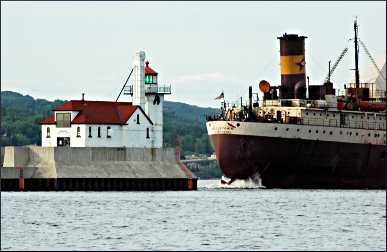
© Torsten Muller
Misfortune hasn't hurt Duluth one bit; to tourists, feeding the gulls and eating ice cream on a warm summer day, it makes the city irresistibly romantic.
Still, Duluth was slow to realize what a natural asset it had lying at its feet. It wasn't until 1986 that it began to clear away the warehouses and debris along the lakefront.
In 1992, the first new hotel opened, and in 1994, the first three miles of the Lakewalk was finished.
Today, horse-drawn carriages and in-line skaters sail by warehouse buildings that now contain galleries, shops, restaurants and coffeehouses.
As the path curves northward, it passes the renovated 1857 Fitger's brewery, now housing an inn, shops, a nightclub and restaurants. Farther on, there are rose gardens and parks.
On a summer day, Duluth is the place to be. Yet its workaday past dogs it, and some people still ask, "What's in Duluth?"
I could say shopping or scenery, and sometimes I do. But what I mostly say is boats, because that's what draws me — and many others — like a magnet.
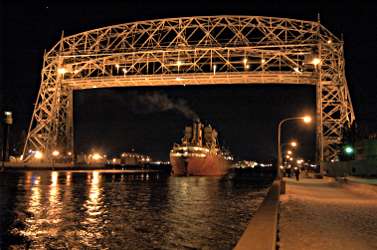
© Torsten Muller
"There's a hard core of people who are just entranced with shipping," says long-time boat nerd Kenneth Newhams. "Those boats are immense. It's something you can't turn away from if you see it."
Trip Tips: Boat watching in Duluth
Boat watching: Check for arrivals and departures compiled by Lake Superior Marine Museum staff; times are estimates.
The staff sometimes misses salties, so for a more accurate view of aproaching boats, check the Marine Vessel Traffic ship tracker. When boats have reached Lakewood, they're about 45 minutes away.
The intra-lakes shipping season usually starts the last week of March, with the opening of the Soo Locks in Sault Ste. Marie and the Welland Canal, which allows ocean-going ships to bypass Niagara Falls.
The first saltie usually arrives the first week of April. Duluth sponsors the annual First Ship Contest; if you guess the arrival time of the first saltie, you get an all-expenses-paid trip to the city.
For tips, see The season's first ships.
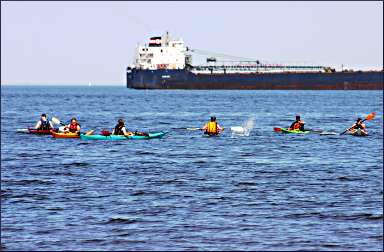
© Beth Gauper
You can also watch ore boats arriving at the Superior Entry, at the tip of Wisconsin Point. You can drive to it through Superior or walk there from the Minnesota side on the Park Point Trail; it's four miles round-trip.
For more, see Dunes of Duluth.
Harbor cruises: From the Duluth dock, across the slip bridge from Canal Park, the Vista Fleet gives 1½-hour narrated cruises from early May through October.
Planning a visit: For sightseeing, festivals, hotels and restaurants, see Duluth 101.
Boat nerds may want to splurge on a corner suite at the South Pier Inn, which have views of the harbor as well as the canal.
Duluth with children: There's a lot for kids to do. For more on the attractions of Canal Park and the lakefront, see Duluth rocks!
More: See our Duluth stories.